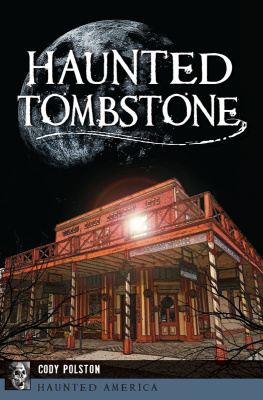IMAGINING TOMBSTONE
CultureAmerica
Erika Doss
Philip J. Deloria
Series Editors
Karal Ann Marling
Editor Emerita
Imagining
Tombstone
The Town Too Tough to Die
KARA L. M C CORMACK
2016 by the University Press of Kansas
All rights reserved
Published by the University Press of Kansas (Lawrence, Kansas 66045 ), which was organized by the Kansas Board of Regents and is operated and funded by Emporia State University, Fort Hays State University, Kansas State University, Pittsburg State University, the University of Kansas, and Wichita State University.
Library of Congress Cataloging-in-Publication Data
Names: McCormack, Kara L., author.
Title: Imagining Tombstone : the town too tough to die / Kara L. McCormack.
Description: Lawrence, Kansas : University Press of Kansas, 2016. | Series:
CultureAmerica | Includes bibliographical references and index.
Identifiers: LCCN 2016000657| ISBN 9780700622238 (cloth : alk. paper) |
ISBN 9780700622740 (ebook)
Subjects: LCSH: Tombstone (Ariz.)History. | Popular cultureArizona
Tombstone. | Popular cultureWest (U.S.)
Classification: LCC F819.T6 M43 2016 | DDC 979.1/53dc23
LC record available at http://lccn.loc.gov/2016000657.
British Library Cataloguing-in-Publication Data is available.
Printed in the United States of America
10 9 8 7 6 5 4 3 2 1
The paper used in this publication is recycled and contains 30 percent postconsumer waste. It is acid free and meets the minimum requirements of the American National Standard for Permanence of Paper for Printed Library Materials Z39.48-1992.
For Finian David and Elijah Dawit,
who may walk into their own legend one day...
ACKNOWLEDGMENTS
I have been living with Tombstone for a number of years now, and I am indebted to many for helping bring this project to fruition. At the University of New Mexico, my academic adviser and committee chair, Dr. A. Gabriel Melndez, was a tremendous influence on and supporter of my work. His work in film and critical regionalism studies greatly affected my own academic endeavor, and his encouragement on this work helped make my arguments stronger and clearer. Dr. Rebecca Schreiber imparted her expertise in popular culture and cultural studies to me, an eager and willing student who realized after a number of meetings about this project that I will always be awed by her knowledge and approach to scholarship. Dr. Paul Andrew Hutton had been an integral part of my studies at the University of New Mexico and continues to be a mentor and wellspring of advice. I thank him for his support and inspiration. My friends and colleagues at the New Mexico Historical Review, most notably Dr. Durwood Ball, were amazingly supportive and encouraging. Dr. Ball continues to offer guidance as I navigate the seas of academia after graduate school, for which I am very grateful.
I want to thank everyone at the University Press of Kansas, especially Michael Briggs for his advice and guidance. I am deeply and forever grateful to Michael Elliott of Emory University and David Wrobel of the University of Oklahoma for their careful reading of my manuscript and thoughtful suggestions for improvement. I would also like to doubly thank David Wrobel for his availability and advice whenever I have needed it. An early version of one of these chapters was published by the Journal of Arizona History, and I thank Bruce Dinges for being so welcoming of my work. Id also like to thank Caitlin Lampman at the Arizona Historical Society. The research for this work was partly funded and fully supported by Stanford University and the Thinking Matters Program, and I would like to thank them for giving me the opportunity to make that last visit to Tombstone, as well as giving me the time and space to finalize this manuscript. I would especially like to thank Ellen Woods, Parna Sengupta, Shelley Fisher Fishkin, Eric Roberts, Allyson Hobbs, and all my friends and colleagues for offering advice, support, and guidance in research and all other academic endeavors.
I would like to thank my family. My sisters Suzanne and Beth helped me study for the GRE all those years ago and have supported me ever since. Suzanne has also been completely willing and available to help me with TIF files and other image questions, making time for me no matter what she had on the grill. My nephews Finian and Elijah have brought such joy to all of us, and I thank them for warming our hearts. I thank my mother, Anne, and my father, Robert, for being so supportive of this endeavor since I came up with the idea years ago. My fathers love for all things western was an early influence on my choice of field, and his continued interest in my work has been a gift to me. I would also like to thank all of my family and friends in New Mexico, Massachusetts, and California who have supported me through time and space, and for that I am forever grateful.
Lastly, I would like to thank the people of Tombstone, both locals and visitors, all of whom opened up to me in ways I could not have imagined before I began. Specifically I would like to thank Bronco Bill Pakinkis, Nancy Sosa, Janice Hendricks, the wonderful people at the beautiful Tombstone Monument Ranch, and all the people I met throughout this journey. You all shared your passion for Tombstone and the Old West and helped me craft a deeper, much more thoughtful exploration into the efforts to sustain this great town.
I cannot thank you enough.
Introduction
The Tombstone Mystique
In 1877 mine prospector Edward Lawrence Ed Schieffelin set out from Fort Huachuca in the Dragoon Mountains in southeast Arizona Territory in search of silver, encouraged by stories of a previous prospector named Frederick Brunckow, a German migr who found silver in the same area decades earlier. As Schieffelin headed east into dangerous Apache territory, he was told by skeptics that all he would find would be his own tombstone. Instead, he found silver. He called the strike Tombstone in response to his critics, and the area went on to become one of the fastest-growing silver mining towns in the West. So it begins.
Of course, the story of the area starts long before this moment. Apaches had been living on this land for centuries before Ed Schieffelin made his discovery. Francisco Vsquez de Coronado brought his expedition through the San Pedro Valley in 1540, and Spanish settlers resided there for close to three hundred years before Arizona came under Mexican rule in 1821. Most of modern-day Arizona was acquired by the United States as part of the Treaty of Guadalupe Hidalgo in 1848, and the Gadsden Purchase pushed the US border to its current limits in the Southwest in 1853. But the official story begins with Schieffelin staking his claim and naming the place Tombstone. Considered the origin story of the city, the founding of Tombstone by Schieffelin is as important to the Tombstone legend as what would become known as the Gunfight at the OK Corral. With the Schieffelin story, Tombstone finds its place among the legends of riches and romance that continue to circulate about the broader West.









